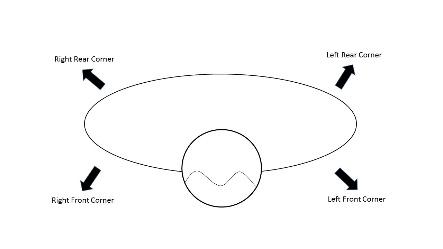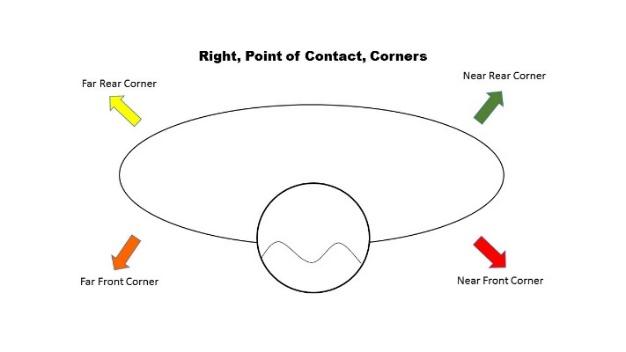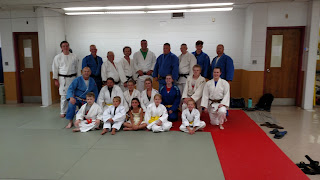Below is the latest article by Coach George Weers.
Introduction
Books published by Judo Champions and various experts offer hundreds of variations of Throwing Actions, Arm Locks, Strangulation maneuvers, Hold Down methods and Leg Triangles. Just, how many of these techniques and maneuvers do we, really, need to play Judo?
In order to address the question of, how many competitive maneuvers, a player needs, let’s look to some of the world’s best players.
Research revealed that World or Olympic Champion is possessed of a technical range of six throws and uses two, of the four families, of newaza skills. One of the throwing skills is likely to be Kouchigari (the Small Inside Reap) and one of the newaza families is, probably, Hold-Down maneuvers. Irrespective of the skills exhibited in a Champion's technical range, those skills and maneuvers have been developed because they fit the personal talents and propensities of that person. Each of the weapons, in the Champion’s arsenal, have been developed through astute planning and arduous training.
There are three important points to be learned from this study.
You have to use the skills that work best for you. You have to stick to what works and practice your skills until they become automatic responses. For the Coach, the lesson of this research is that we have to help focus our players on their best skills.
Coaches need to help find the maneuvers that work best for each player through, careful, observation, documentation and reinforcement.
Perhaps, more importantly, none of the champions were using exotic maneuvers. The champions, in this study, caught everybody off guard through efficiency and preparatory action. The skills being used by the Champions, in this study, are the same skills that you and I practice and teach players every day. These Champions developed skills to their full potential. Developing to full potential should be the objective of every player and Coach. Irrespective of the venue, those who fulfill their potential will always be Champions.
Understanding that the best players focus on a few techniques and maneuvers, with which they are skilled and confident, is an important step toward developing one’s own repertoire of skills. However, we also need to understand how those skills are applied.
Practical Application
Corners
Video analysis of over 2000 throwing actions has revealed that attacks, which drive directly forward, to the rear or directly laterally are ineffective. Such, direct, attacks are ineffective because the attacker is going against the defenders strongest and most mobile positions. Basically, you’re trying break to through the walls of a fortress. What you need to do is chip away at the corners of the castle.

Your opponent is possessed of four corners, against which, we apply throwing actions. Those corners are the Left Front, Right Front, Left and Right Rear Corners. If there are four corners to be attacked then you need throwing actions that drive the opponent into each corner. Now the question becomes; ‘which throwing actions work against, which, corner?’
Sequence of Development
Development of throwing actions to each of the opponent’s corners is, in actuality, development of a Personal Attack System (PAS). Your PAS, logically, begins with determination of your dominant, or strongest, leg.
Our bodies do not develop or function in perfect symmetry. Close examination of facial features reveals minor discrepancies between right and left sides. The hemispheres of the brain control distinctly different functions. We develop dominance of use of one hand, or the other. As people utilize a dominant hand, so do they favor one, or the other, leg. It is an error to assume that dominant leg can be determined by the dominant hand. You need to test each person for leg dominance.
Here are two simple test, through which, the dominant leg may be found.
The Wall Push
The subject stands, slightly, more than arms-length away, facing a wall / immovable object
Instruct the subject to push the wall / immovable object as hard as possible
Allow the subject to push for 20 to 30 seconds
Record, with which, leg the subject pushes
One Leg Stand
Instruct the subject to close his/her eyes and stand on one leg.
Allow the subject to push for 10 to 15 seconds
Record, with which, leg the subject pushes
It is not necessary to utilize both tests. With either test the subject will employ his/her dominant leg.
The significance, and interpretation, of this test lies in the basic mechanics of bipedal locomotion. When we walk or run, in order to move the right side, of our bodies, we push with the left leg. Conversely, moving the left side requires motive force from the right leg.
If the subject has utilized his/her right leg, to stand or push, the subject should develop as a Left Side player. Conversely, pushing with the left leg indicates a Right Side player. Early determination of leg dominance ensures efficient development and eliminates, potential, frustration in, both, player and Coach.
How does your dominant leg influence development of maneuvers against the opponent’s four corners?
Your dominant leg dictates which side of your body will be closest to the opponent. A dominant left leg means you keep your right side forward. Conversely a right dominant leg means the left side will be forward.
When we execute throwing actions, the force, with which we intend to push the opponent’s back to the mat, is generated through the dominant leg. That force is transmitted through your Point of Contact, which is, usually, on the opponent’s torso. Your Point of Contact also dictates how far you have to travel, or the ‘size’ of attack against each corner.
The graphics, appended here, are color coded to illustrate distance / required size of action for each corner in relation to the Point of Contact. The colors indicate;
Green – Near Rear Corner; shortest distance, simplest and safest action
Yellow – Far Rear Corner; moderate travel and moderate exposure to counter attack
Orange – Far Front Corner; considerable travel with complex action and significant exposure to counter attack
Red – Near Front Corner; because your body is at this corner the greatest travel is required with highest exposure to counter attack 

Throwing Actions
An, extremely, effective approach to teaching is to begin with simple concepts and, gradually, develop more complex aspects of the subject. We see this in math where students, first, learn simple functions, such as addition and subtraction prior to moving on multiplication, etc. Similarly, art students begin by representing geometric shapes. This, simple-to-complex, progression utilizes two, important, concepts.
Developing competence in the base, or core, functions/components of the subject as the primary objective. Where facility with core functions exist the ability to higher function is guaranteed.
Success breeds success: The idea that success breeds success is an example of a positive spiral. A positive spiral exists when a person succeeds, which engenders confidence, which leads to seeking further success, etc., etc., etc. …
Isolated Incidents vs. Situational Coaching
What we’re talking about here is Situational Coaching.
A common approach to teaching Judo is that of ‘isolated incidents’. i.e. The Coach stands before the group, announces that he/she will teach, Tai Otoshi / Uchimata / Seoinage, and then, with a static partner, proceeds to execute the maneuver. Upon completion of the demonstration the group is directed to mimic the technique. What’s wrong with this picture?
Demonstration of isolated incidents offers no context. Movement, the most important aspect of context, is seldom present. Defense and transition, both of which are crucial to development of, full, facility Judo are seldom present. Learning through isolated incident may develop the ability to demonstrate techniques as isolated incidents but that doesn’t do a lot of good when an opponent, with malevolent intent, is at the end of your arms.
The basic concept of Situational Coaching can be expressed through a very simple question. “Here I am, what can I do from here?” Situational Coaching does not present isolated techniques. Situational Coaching offers options.
Core Elements
In order to apply situational coaching, toward development of a personal range of throwing actions, it’s important to identify the core elements of situations where throwing actions may be applied. By subtracting specificity of mechanical action, I have identified the following elements of throwing actions to be ‘core’ to execution.
Posture
|
Mobility
|
Grip Configuration
|
Control of Space between the players
|
Drive/Supporting Leg Positions
|
Of these core elements posture is the most important. The influence of posture includes, but is not limited to, the direction you, and your partner, face; your spatial orientation to the opponent; potential mobility of both players; the type of, available, gripping configuration; the placement of the defender’s supporting leg, which is your objective of attack, indicates where you need to place your driving leg…..
As you can see, posture influences a great deal. Dwelling on all the influences of posture would, once again, create confusion. That’s why, we need a core element, on which, decisions may be founded and, from which, success may emerge. The simplest, and most easily identified, element of posture is the direction in which the players face. Basically, partners either face one another or face, generally, the same direction. What type of throwing action can be applied to these, simple, situations?
The opponents are, generally, facing one another. When facing the opponent, the attacker’s objective is to influence the defender’s torso and takes-away his/her legs. Throwing actions that work in this manner are foot sweeps, trips and blocks, hooks such as Big Inside and Big Outside Hooks. (Ouchi & Osoto Gari)
Turn Around Actions: The opponents are, generally, facing in the same direction. (The attacker is facing away from, or the same direction as, the defender while the defender has a view of the back of the attacker’s head). When facing away from the opponent, you need to obstruct the torso, or hips, with a barrier/obstacle and propel the opponent’s torso over or around the barrier. Techniques, applicable to the situation, include, but are not limited to, Hip Throws, Swinging Leg actions (Uchimata, Harai Goshi, etc.), Shoulder Throws and Tai Otoshi.
The attacker drops to the mat in an effort to throw the opponent. While dropping, the attacker isolates the opponent’s legs and propels the torso by falling to the mat.
It is important to note that, though the attacker is dropping to mat during the throwing action, the principle of which direction the players are facing still applies. If the opponent’s face one another, then the objective is to influence the defender’s torso and, through the dropping action, takes-away his/her legs. When facing in the same direction the attacker, either in front of or behind the defender, you still need to obstruct the torso, or hips, with a barrier/obstacle and propel the opponent’s torso over or around the barrier.
Somersault throws (Tomoe Nage, Sumi Gaeshi) and maneuvers where you drop into a ‘hurdle stretch’ are applied where partners are facing one another. Pick-Up actions (Ura Nage etc.) are applied when the opponent turns his/her back to you.
Throwing Actions and the Corners
Let’s look at which throwing actions to apply to which corner from a situational perspective. We’ll start at the Near Rear Corner for two reasons.
1. The near rear corner requires the least travel and exposure, to counter attack.
2. Attack configuration, against the Near Rear Corner, is simple.
Situation: You are facing your opponent, which indicates that you need to attack the legs and push the torso into the Near Rear Corner. Contingent on the opponent’s movement pattern you might Push the Near Foot as it travels (Foot Sweep action), block the Near Foot, or leg, with your Foot/Leg (Small Outside Trip) or Hook the Near Leg, from the Inside, and push the opponent to the mat (Big Inside Hook). Throwing actions should be completed with a continuation to ground play. Ground play should be explored through situational training.
What happens if the opponent is able to avoid your attack? We simply attack another corner.
Avoiding attack to the Near Rear Corner, usually, exposes the Far Rear Corner to attack.
Situation: Through avoidance of attack to the Near Rear Corner the opponent has exposed his/her Far Rear Corner. You are still facing the opponent, which suggests attacking the legs as the appropriate course of action. In order to reach the Far Leg, you need to extend your own leg. Contingent on movement patterns of you and your opponent you might; reach across and capture the, opponent’s Far Foot with the Foot of your Free Leg (Small Inside Reap/Hook). You could also extend the Free Leg, Hook the Opponent’s Far Leg and drive him/her into the Far Rear Corner. (Big Outside Reap/Hook). Another option is to, simply, extend your Free Leg and Trip the opponent as he/she travels to the Far Rear Corner. Situational ground play should be included.
Once again the opponent is able to avoid your attacks against the Far Rear Corner.
The first two training situations have focused on attacking to the rear corners. Our next situation will explore opportunities in attacking the Far Front Corner.
Turning away from the opponent entails more precise timing and more complex mechanics than attacking the rear corners. In order to limit the opponent’s defensive options, your weight needs to hang on the opponent throughout the turn. Mechanical efficiency dictates that your, inside, hip and point of contact lead you into attack configuration. In order to prevent the opponent from forestalling your attack configuration, you need to trap/isolate his/her Far Arm. If any of these aspect are inadequate then, at best, the attack is compromised, worse yet, the attacker is open to counter attack.
Situation: In response to the opponent’s defense against the attack to his/her Far Rear Corner, we’re going to turn around, face away from the opponent and attack the Far Front Corner. When facing away from the opponent you need to obstruct the torso, or hips, with a barrier/obstacle and propel the opponent’s torso over or around the barrier. Throwing actions, which fulfill these criteria include, but are not limited to;
Hip and Shoulder Throws (Turn Around Stick-Out your Hip and Push the opponent around the hip)
Swinging Leg Actions (Harai Goshi, Uchi Mata, etc): Turn Around, Stick-Out your leg and roll the opponent over, and/or around the leg.
Include situational ground play and you’ve fulfilled the process of Judo to another corner.
Now we’re going to address the most challenging corner.
The opponent’s Near Front Corner is the most challenging corner to attack because the attacker is standing in the path of the throwing action. How can you get out of the way?
Situation - Using Inertia: The defender has interrupted your attack to his/her Far Front Corner. Attacks to the front corners require significant energy/movement to mount and a, correspondingly, significant, amount of energy/movement to interrupt. That energy does not dissipate, simply, because the attack was interrupted. That energy persists as inertia. The key to attacking the Near Front Corner is to utilize that inertia. When the opponent interrupts your attack, follow the inertia, of attack and defense. Utilize that inertia to help you turn to an attack configuration into the Near Front Corner. Cross-Over maneuvers, i.e. attacking left from a right grip, are very powerful weapons, when applied to the Near Front Corner. Cross-Over maneuvers are especially powerful weapons when combined with the inertia of an interrupted attack.
Situation – Wrap and Roll: There are a few throwing actions, wherein, the attacker begins facing the opponent and, through execution of the throw, turns and faces the opposite direction. The concept is quite simple. Create one mass, from your body and the opponent’s, then drive your chest to mat. Throwing actions, which are so executed, include but are not limited to, Ura Nage, the Wrestling Suplex and the Kharberli.
The, above named, Wrap and Roll maneuvers are advanced techniques, which could become dangerous if introduced to, insufficiently skilled, players. When practicing Wrap and Roll maneuvers, a crash pad is an important safety precaution.
The Foot Block (Sasae Tsuri Komi Ashi), however, though utilizing the principle of the wrap and roll, can be developed safely and attacks the opponent’s Near Front Corner.
You will have, no doubt, noticed that ‘Dropping’ maneuvers were not mentioned in the training situations. The drops were not included because;
The focus of this article is toward the development of intermediate players.
Dropping actions are advanced maneuvers, which require precise timing and mechanical actions.
Dropping actions are, highly, specialized maneuvers. They should be reserved for those players who demonstrate propensity for such actions.
Conclusion
The, above outlined, situations have been constructed to develop an attack sequence flowing from the easiest to the most challenging target. The key component, in the attack sequences, is that specific attack configuration has been supplanted with, general, mechanical objectives. Situational Coaching does not mandate maneuvers. Situational Coaching suggests possible solutions and encourages players to find an approach that works best for that individual. Situational Coaching reduces the burden of detail and the stress of decision.
Competitors don’t need to know hundreds of attacking actions. They need to develop five, or six, maneuvers that work best for them. Reducing detail, through Situational Coaching, allows your players the freedom to find those skills.






























